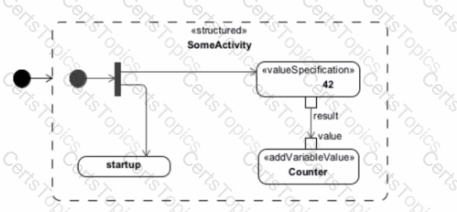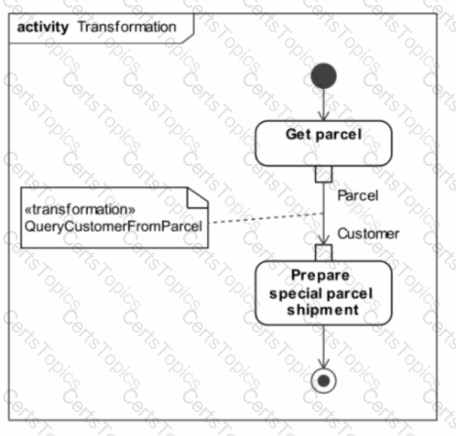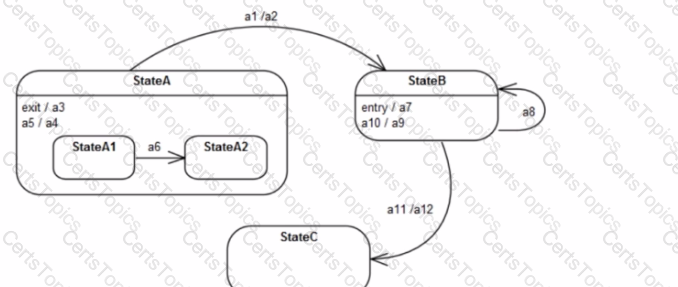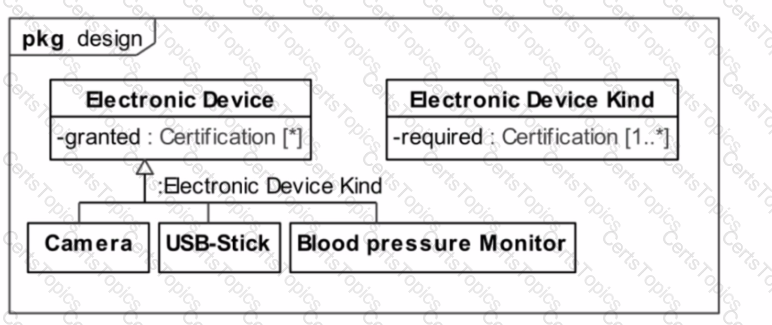Choose the correct answer:
Which concept is used in AN to represent a model element such as a class or an activity?
Choose the correct answer:
What happens when an exception is raised by an Action within an Activity that has been invoked asynchronously?
Choose the correct answer:
What does the UML specification say about choosing between a MOF-based metamodel and a UML profile?
Choose the correct answer:
Where does UML explicitly intend String Expression elements to be used?
Choose the correct answer:
What is true about the use of a Template Classifier to specify the Type of a Typed Element?
Choose the correct answer:
What characterizes the generalization relationship between two Classifiers wherethe child can NOT be substituted for the parent?
Choose the correct answer:
Consider the following diagram fragment:

What is the value of "Counter" before the SomeActivity Action is executed?
Choose the correct answer:
Which statement is correct about the compiled model resulting from Alt text?
Choose the correct answer:
Consider the following diagram fragment:

What is "QueryCustomerFromParcel"?
Choose the correct answer:
Can State Machine Events have Features?
Choose the correct answer:
An organization has determined that they want to add the capability to create and add requirement elements to their UML models. They also want to create a unique relationship for tracing requirements to other model elements.
What is the appropriate approach to do this?
Choose the correct answer:
What two protocol state machine interpretations can be defined?
Choose the correct answer:
Which capability enables the discovery and manipulation ofmetaobjects and metadata''
Choose the correct answer:
Which UML element specifies a set of formal parameters that will be substituted by actual parameters?
Choose the correct answer:
Consider the following diagram fragment:

Which diagram fragment correctly specifies task behavior based on task priority?
A)

B)

C)

D)

Choose the correct answer: What is the value of EMOF?
Choose the correct answer:
What is correct about the modeling of individual things with UML?
Choose the correct answer: What is the scope of fUML?
Choose the correct answer:
What is true about a MOF 2.x Model?
Choose the correct answer:
Which class sits at the top of the MOF class hierarchy?
Choose the correct answer: Consider the following diagram fragment:

Assume that the system is in StateAl Which sequence of triggers will move the system to StateC?
Choose the correct answer:
Consider the following diagram fragment:

What is the signature of the class template List?
Choose the correct answer:
Consider the following diagram:

Which statement is correct about the diagram?
Choose the correct answer:
In addition to ObjectFlow. which mechanism could be used to move data within an Activity?
Choose the correct answer:
What does the MDA approach support?
Choose the correct answer:
In a model of a commercial transaction, actors might exchange euros, pesos, and dollars
Which figure illustrates compliant use of UML information items for these currency exchanges?


Choose the correct answer:
Which feature of a UML model element could NOT be adapted by a Stereotype?